Books
Books

Going to Love You
This new body of work consists of paintings featuring heart-headed figures in various emotional states and situations that sometimes teeter between the ordinary and extraordinary. From tender amorous moments to unexpected skate scenes, the work is full of the next iteration of emotive "schmoo" characters.
Mark Gonzales ("The Gonz") is an American artist and professional skateboarder best known for his profound contribution to the development of street skateboarding from the mid-1980s onward. Gonzales' creative outlook is evident in his ability to perform inventive new tricks using the existing framework of urban architecture like handrails, stairs, and ledges. His artwork grew out of the same environment as his skateboarding and includes illustrating zines, which often have surreal and humorous characters, as well as producing and collaborating on projects with Harmony Korine and Spike Jonze. Born on June 1, 1968 in South Gate, CA, he began skateboarding by the age of 13 and formed the company Blind Skateboards in 1989. While pursuing his sporting career, the artist began drawing in his free time and created graphics for Krooked Skateboards. Since then, he has collaborated with the clothing brand Supreme and Adidas to name just a few. He lives and works in New York.
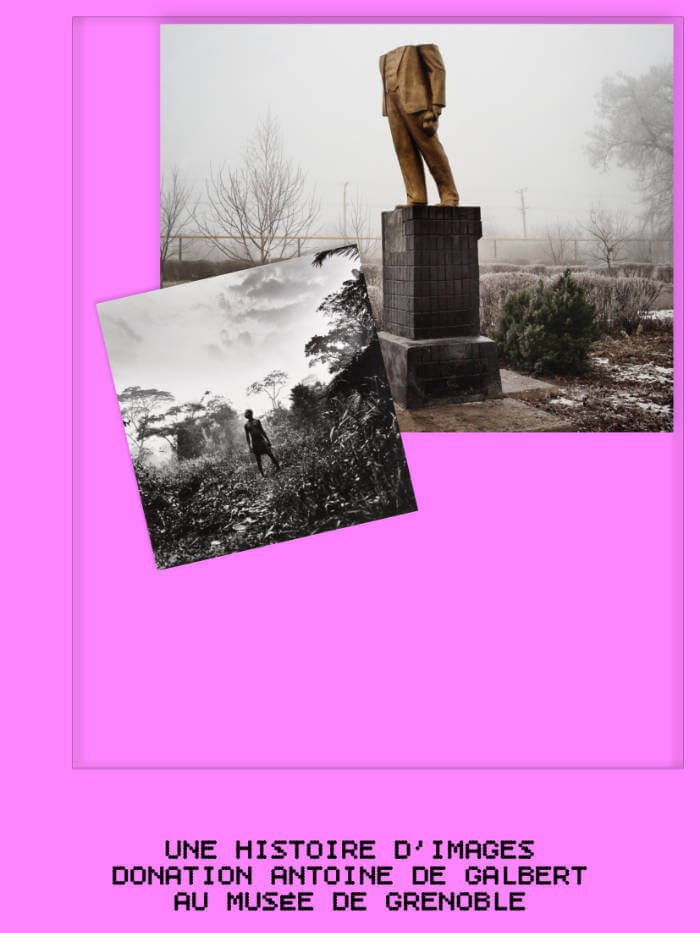
A history of images / Une histoire d'images
Noëlig Le Roux, Guy Tosatto and 1 more
Through more than 500 images by 95 photographers, the Musée de Grenoble's collection of photographs from Antoine de Galbert's collection and his foundation offers an impressive panorama of our times and the decisive role played by photography in shaping our perceptions and contemporary mythologies.
Works by Aalam, Bani Abidi, Antoine d'Agata, Lucien Aigner, Pilar Albarracín, Yolanda Andrade, Sammy Baloji, Ion Bîrlădeanu, Eric Baudelaire, Philippe Bazin, Guillaume Binet, Alain Bizos, Antoni Campana, Mario Carnicelli, Henri Cartier-Bresson, Jean-Philippe Charbonnier, Chieh-Jen Chen, Roman Cieslewicz, Christian Courrèges, David Damoison, Philippe De Gobert, Luc Delahaye, Bernard Descamps, Jean-Marie Donat, Alfred Eisenstaedt, Sandra Eleta, Fouad Elkoury, Charles Fréger, Alberto García-Alix, Laurence Geai, Agnes Geoffray, Julien Gester, Stephan Gladieu, David Goldblatt, Hengameh Golestan, Cosmin Gradinaru, Guillaume Herbaut, Chester Higgins, Kati Horna, John Isaacs, Olivier Jobard, Alain Keler, Yevgeny Khaldeï, Chris Killip, Sirkka-Liisa Konttinen, Oleg Kulik, Olivier Laban-Mattei, Stéphane Lagoutte, Dorothea Lange, Le Tiers Visible, Arthur Leipzig, Alexandre Lewkowicz, Pascal Maître, Yuri Mechitov, Davood Maeili, Edouard Méhomé, Georges Melet, Lívia Melzi, Boris Mikhaïlov, Lisette Model, Etienne Montes, Yan Morvan, Genevieve Naylor, Vladimir Nikitin, Martin Parr, Paolo Pellegrin, Mathieu Pernot, Gilles Raynaldy, Marc Riboud, Sophie Ristelhueber, Hugo Schmölz & Karl Hugo Schmölz, Chantal Stoman, Paul Strand, Mikhael Subotzky, Barthélémy Toguo, Tomasz Tomaszewski, James-Iroha Uchechukwu, Alex Van Gelder, Erwan Venn, Weegee, Where dogs run, Sue Williamson, Wiktoria Wojciechowska, Pavel Wolberg, Tom Wood, Patrick Zachmann, Miron Zownir.
Texts by Antoine de Galbert, Guy Tosatto, Noëlig Le Roux, Antoine Champenois, Joséphine Givodan.
Published on the occasion of the eponymous exhibition at the musée de Grenoble from December 2023 to March 2024.

"If you slap the water, you hurt the heads of the fish"
The first comprehensive monograph devoted to artist Bea Schlingelhoff.
Conceived on the occasion of Bea Schlingelhoff's solo exhibition No River to Cross at Kunstverein München, this publication extends far beyond this to survey fifteen years of her artistic practice through imagery, ephemera, and various texts. Additionally, the publication brings together five newly commissioned pieces of writing, penned by Catherine Chevalier, Gloria Hasnay, Christina Irrgang, Helene Moll, and Sadie Plant, each focusing on a specific body of Schlingelhoff's work. Each book is one of a kind and bound in different endpapers from the private collection of the artist's father.
Edited by Gloria Hasnay.
Texts by Catherine Chevalier, Gloria Hasnay, Christina Irrgang, Helene Moll, Sadie Plant.
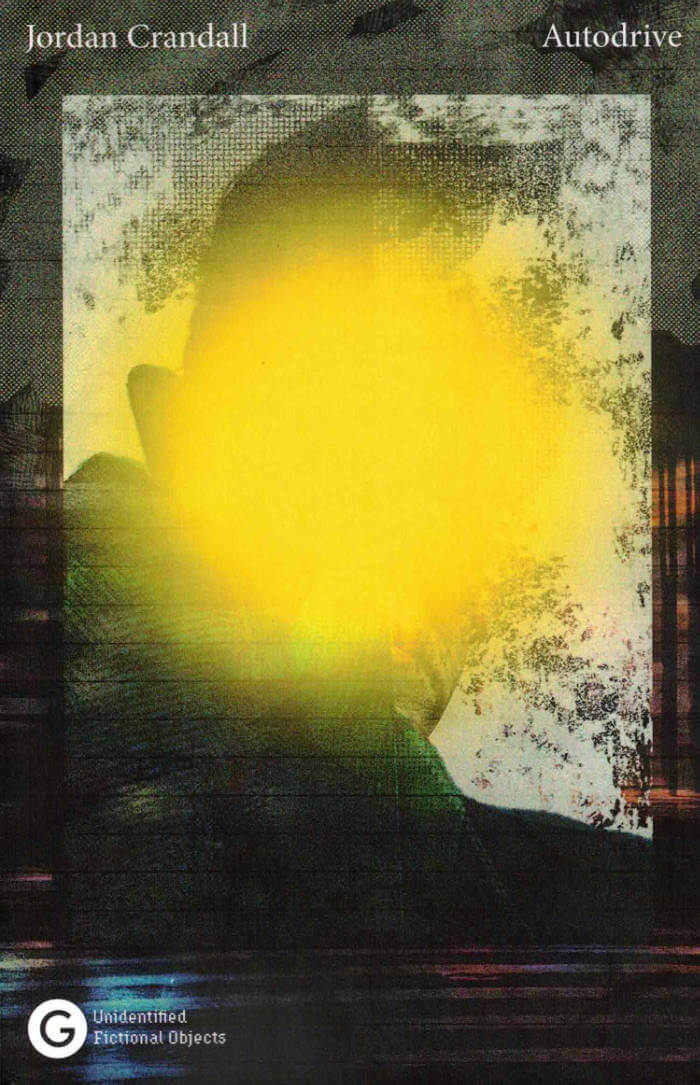
Autodrive
A literary odyssey along the highways at a time when a new form of superintelligence has emerged.
Autodrive is a work of literary fiction that melds techno-scientific inquiry and storytelling, critical theory and comedy, speculative fiction and satire. It is a road novel of sorts, an odyssey along the highways at a time when a new form of superintelligence has emerged. This new form of artificial intelligence is not entirely distinct from the characters in the narrative—it is ingrained in the machines they already use, the vehicles they already take, the systems they are already part of, but cannot fully see. The human character who is typically at the center of the fictional world gives way to an eccentric cast of performers—an ensemble of people and machines.

Lava Lines
Lava Lines explores the life forms, contemporary myths and geopolitical powers that shape volcanic landscapes. It gathers poetry, role play's transcription, film scripts and visual works of several artists, to touch on collective memory, non-human agency and myth-making.
The art works presented in the publication are by Leïla Arenou, Francisca Khamis, Naïmé Perrette, Camille Picquot, Rachel Pimm, Francisca Khamis, Juliette Lizotte, Riar Rizaldi and Arif Kornweitz
It also archives live performances/screenings by Francisca Khamis, Arif Kornweitz, Mika Oki, Chooc Ly Tan, Adán Ruiz, Ana Vaz, and Rieko Whitfield.

God Made My Face: A Collective Portrait of James Baldwin
Baldwin's life and legacy as remembered by a pantheon of artists and writers: from Jamaica Kincaid and Barry Jenkins to Richard Avedon and Alice Neel.
When author James Baldwin died in 1987, he left behind an extraordinary body of work: novels, poems, film scripts and, perhaps most indelibly, essays. A friend and supporter of Martin Luther King Jr., Malcolm X and Medgar Evers, Baldwin was a critical voice in the civil rights movement. After reaching acclaim in his early career as a writer, he struggled to retain the author's "I," while taking on the "we" of the people.
Edited by Pulitzer Prize-winning author Hilton Als and growing out of his landmark exhibition at David Zwirner in 2019, God Made My Face brings together an impressive assembly of contributors, ranging from Baldwin biographer David Leeming to novelist Jamaica Kincaid and Moonlight director Barry Jenkins, to create a memorial mosaic: one that not only mirrors Baldwin's various tones but also closely examines his singular contributions to cinema, theater, the essay and Black American critical studies. These essays are illustrated by artwork from modern and contemporary artists who were either personal contemporaries of Baldwin or directly inspired by his work. In each piece assembled here, the authors speak from a personal, informed perspective, illuminating Baldwin's deeply anguished and enlightened voice and his belief that, ultimately—because we are human—we share the potential to love, connect and live together in all our glory.
Artists include: Diane Arbus, Eugène Atget, Richard Avedon, Don Bachardy, Alvin Baltrop, Anthony Barboza, Njideka Akunyili Crosby, Beauford Delaney, Marlene Dumas, Glenn Ligon, George McCalman, Alice Neel, Elle Pérez, Cameron Rowland, Kara Walker, James Welling, Larry Wolhandler.
Authors include: Stephen Best, Daphne A. Brooks, Teju Cole, Marianne Jean-Baptiste, Barry Jenkins, Jamaica Kincaid, David Leeming, Darryl Pinckney.

Subcontinental Synthesis
The history of India's first electronic music studio founded in 1969 at the National Institute of Design in Ahmedabad by David Tudor.
Subcontinental Synthesis explores the history of India's first electronic music studio, founded in 1969 at the National Institute of Design in Ahmedabad with the support of the composer David Tudor. The essays and writings unravel the narrative and context surrounding the studio as well as the work of the Indian composers who created groundbreaking recordings during its four years of activity. The texts reflect on the role of electronic music within a post-independence India, considering its interconnections with experimental design, radical pedagogies, and the international avant-garde, as well as the encircling conditions of Western ideological soft power within the global expansion of Modernism.
Contributors: Geeta Dayal, Alannah Chance, Matt Williams, Shilpa Das, Jinraj Joshipura, You Nakai, Rahila Haque, and Paul Purgas.

When Technology Was Female: Histories of Construction and Deconstruction, 1917-1989
Continuities and ruptures between the early Soviet (c.1917) and late state socialist (c.1980s) periods are examined through detailed discussions of a wide range of women’s artistic practices, including Liubov Popova, Varvara Stepanova, Tina Bara, Sibylle Bergemann, Věra Chytilová, Natalia LL, Dora Maurer, the Erfurt Women Artists’ Group, Běla Kolářová, Evelyn Richter, Zorka Ságlová, and many others. Featuring over one hundred images of works ranging from costume sketches and stage maquettes, to photographs and film stills, the book offers a sweeping study of over seventy years of women’s artistic production and is meant for any reader engaged at the intersections of feminist and (post-)socialist art histories.
Graphic design: Experimental Jetset
Managing editor: Megan Hoetger
Series editor: Frédérique Bergholtz
Copy editor: Janet Grau

Colonial Toxicity: Rehearsing French Radioactive Architecture and Landscape in the Sahara
Between 1960 and 1966, the French colonial regime detonated four atmospheric atomic bombs, thirteen underground nuclear bombs and conducted other nuclear experiments in the Algerian Sahara, whose natural resources were being extracted in the process. This secret nuclear weapons programme, whose archives are still classified, occurred during and after the Algerian Revolution, or the Algerian War of Independence (1954–62). This publication brings together nearly six hundred pages of materials documenting this violent history of France’s nuclear bomb programme in the Algerian desert.
Meticulously culled together by the architectural historian from across available, offered, contraband, and leaked sources, the book is a rich repository for all those concerned with histories of nuclear weapons and engaged at the intersections of spatial, social and environmental justice, as well as anticolonial archival practices.
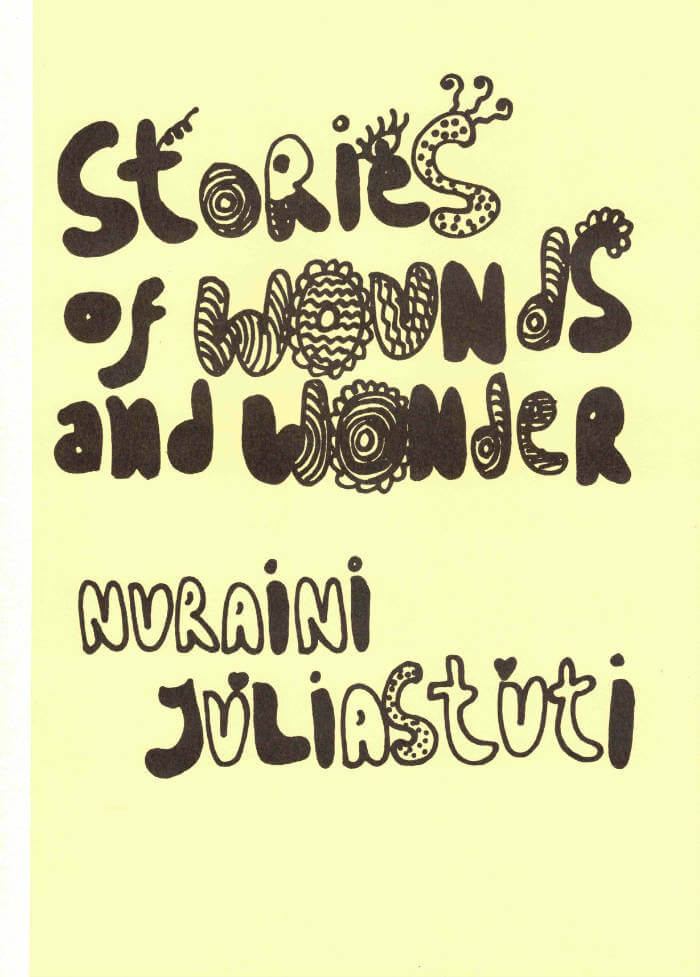
Stories of Wounds and Wonder
This experimental children’s book narrates cross-species practices of survival across the Indonesian archipelago, centring the perspectives of local animals such as endangered monkeys, cosmopolitan rats, migrant sparrows and fugitive dogs. Written in the form of a play, its six episodes ground the readers in the animals’ struggles and aspirations as they go about their daily lives and face the consequences of postcolonial erasure, ecological destruction and capitalist expansion. While the stories unfold, their interconnected existences become an archive of uncertainties, where the fate of many different creatures, humans included, is inseparable from each other.
As a script for intergenerational transmission, the book thoughtfully combines dialogues, songs and drawings, with contextualising essays and extensive notations. Through these different modes of reading, children and adults alike will learn about cross-species solidarity and rebellious movements, but also about disappearing Indigenous cosmologies, and the brave women who wove cloths around the mountains in eco-political resistance.

Playboy
The prequel to Love Me Tender, narrating Debré's transformation from affluent career woman to broke single lesbian and writer.
I see all her beauty, I see the beauty of women. I see my own body, new. I tell myself there are so many things that are possible.
First published in France in 2018, Playboy is the first volume of Constance Debré's renowned autobiographical trilogy that describes her decision, at age forty-three, to abandon her marriage, her legal career, and her bourgeois Parisian life to become a lesbian and a writer.
The novel unfolds in a series of short, sharp vignettes. The narrator's descriptions of her first female lovers—a married woman fifteen years older than her, a model ten years her junior—are punctuated by encounters with her ex-husband, her father, and her son.
As Debré recently told Granta: “It was a bit like Saint Augustine and his conversion. In the same week, I had sex with a girl and I had the feeling that I could write. I had this incredible feeling that I could catch things, that life was there to be caught.”
Looking at the world through fresh eyes, the narrator of Playboy questions everything that once lay beneath the surface of her well-managed life. Laconic, aggressive, and radically truthful, she examines gender and marriage, selfishness and sacrifice, money and family, even the privilege inherent in her downward mobility.
Writing her way toward her own liberation, Debré chronicles the process that made her one of the most brilliant, important French writers today.

Notice
A classic queer text of trauma, written by one of the most talented novelists of her generation.
Published by Doubleday in 1994, Heather Lewis's chilling debut novel took place on the northeastern equestrian show-riding circuit, to which Lewis herself belonged in her teens. Expelled from boarding school, its fifteen-year-old narrator moves numbly through a world of motel rooms, heroin, dyke love, and doped horses. Kirkus Reviews found it “brutal, sensual, honest, seductive … a powerful debut,” while the New York Times found the book “grating and troublesome … it's difficult to imagine a more passive specimen.”
Almost immediately, Lewis began writing Notice, a novel that moves even further into dark territory. The teenaged narrator Nina begins turning tricks in the parking lot of the train station near the Westchester County home of her absent parents. She soon falls into a sadomasochistic relationship with a couple. Arrested, she's saved by a counselor and admitted to a psychiatric facility. But these soft forms of control turn out to be even worse. Writing in the register of an emotional fugue state, Notice's helpless but all-knowing narrator is as smooth and sharp as a knife.
Rejected by every publisher who read it during Lewis's life, Notice was eventually published by Serpent's Tail in 2004, two years after her death. The book, long out of print, emerged as a classic queer text of trauma, written by one of the most talented novelists of her generation.

Heroines, New Edition
A manifesto reclaiming the wives and mistresses of literary modernism that inspired a generation of writers and scholars, reissued after more than a decade.
On the last day of December 2009, Kate Zambreno, then an unpublished writer, began a blog called "Frances Farmer Is My Sister," arising from her obsession with literary modernism and her recent transplantation to Akron, Ohio, where her partner held a university job. Widely reposted, Zambreno's blog became an outlet for her highly informed and passionate rants and melancholy portraits of the fates of the modernist “wives and mistresses," reclaiming the traditionally pathologized biographies of Vivienne Eliot, Jane Bowles, Jean Rhys, and Zelda Fitzgerald: writers and artists themselves who served as male writers' muses only to end their lives silenced, erased, and institutionalized. Over the course of two years, Frances Farmer Is My Sister helped create a community of writers and devised a new feminist discourse of writing in the margins and developing an alternative canon.
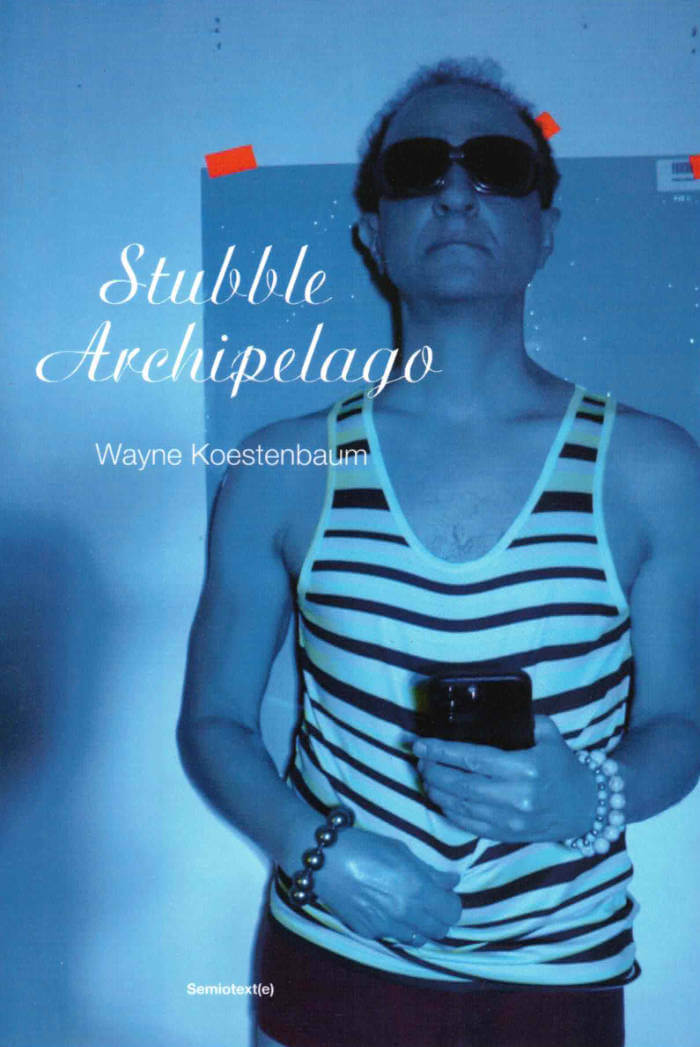
Stubble Archipelago
Wild new adventures in word-infatuated flânerie from a celebrated literary provocateur.
This book of thirty-six poetic bulletins by the humiliation-advice-giver Wayne Koestenbaum will teach you how to cruise, how to dream, how to decode a crowded consciousness, how to find nuggets of satisfaction in unaccustomed corners, and how to sew a language glove roomy enough to contain materials gathered while meandering.
Koestenbaum wrote many of these poems while walking around New York City. He'd jot down phrases in a notebook or dictate them into his phone. At home, he'd incorporate these fragmented gleanings into overflowing quasi sonnets. Therefore each poem functions as a coded diary entry, including specific references to sidewalk events and peripatetic perceptions. Flirting, remembering, eavesdropping, gazing, squeezing, sequestering: Koestenbaum invents a novel way to cram dirty liberty into the tight yet commodious space of the sonnet, a fourteen-lined cruise ship that contains ample suites for behavior modification, libidinal experiment, aura-filled memory orgies, psychedelic Bildungsromane, lap dissolves, archival plunges, and other mental saunterings that conjure the unlikely marriage of Kenneth Anger and Marianne Moore. Carnal pudding, anyone? These engorged lyrics don't rhyme; and though each builds on a carapace of fourteen lines, many of the lines spawn additional, indented tributaries, like hoop earrings dangling from the stanzas' lobes.
Koestenbaum's poems are comic, ribald, compressed, symphonic. They take liberties with ordinary language, and open up new pockets for sensation in the sorrowing overcoat of the “now.” Imagine: the training wheels have been removed from poetry's bicycle, and the wheeling flâneur is finally allowed a word pie equal to fantasy's appetite. Stubble—a libidinal detail—matters when you're stranded on the archipelago of your most unsanctioned yet tenaciously harbored impulses.
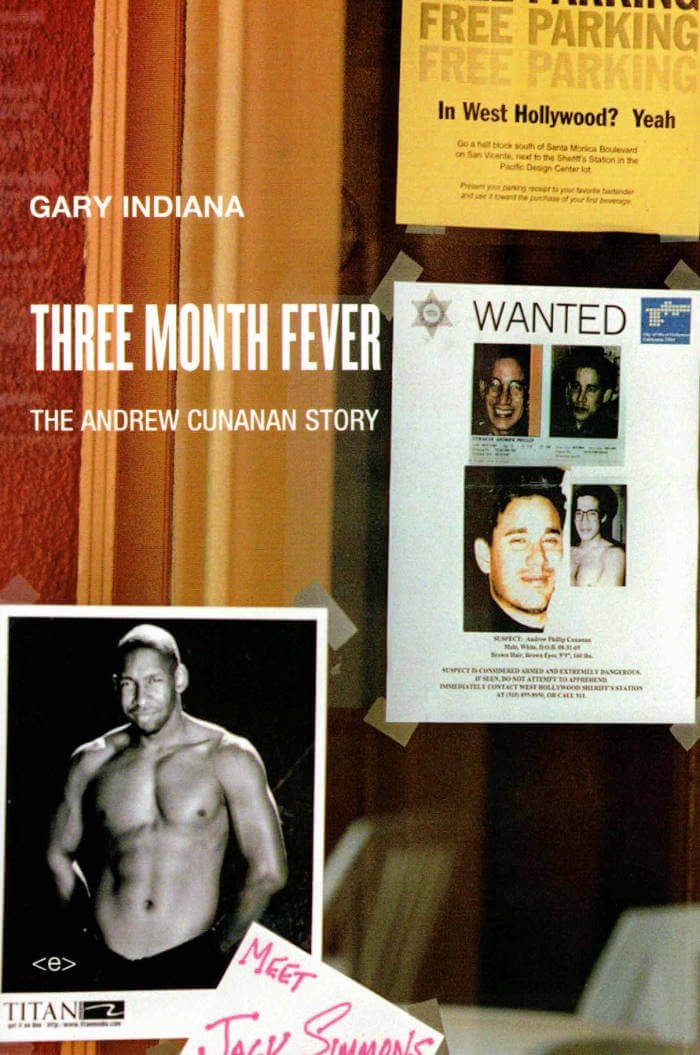
Three Month Fever: The Andrew Cunanan Story
A sardonic and artful reconstruction of the brief life of the party boy who became a media sensation for shooting Gianni Versace.
First published in 1999, Gary Indiana's Three Month Fever is the second volume of his famed crime trilogy, now being republished by Semiotext(e). (The first, Resentment, reissued in 2015, was set in a Menendez trial-era L.A.) In this brilliant and gripping hybrid of narrative and reflection, Indiana considers the way the media's hypercoverage transformed Andrew Cunanan's life “from the somewhat poignant and depressing but fairly ordinary thing it was into a narrative overripe with tabloid evil.”
“America loves a successful sociopath,” Indiana explains. This sardonic and artful reconstruction of the brief life of the party boy who became a media sensation for shooting Gianni Versace is a spellbinding fusion of journalism, social commentary, and novelistic projection. By following Cunanan's notorious “trail of death,” Indiana creates a compelling portrait of a brilliant, charismatic young man whose pathological lies made him feel more like other people—and more interesting than he actually was. Born in a working-class exurb of San Diego and educated at an elite private school, Cunanan strove to “blend in” with the upscale gay male scene in La Jolla. He ended up crazed and alone, eventually embarking on a three-month killing spree that took the lives of five men, including that of Versace, before killing himself in a Miami boathouse, leaving behind a range of unanswerable questions and unsolvable mysteries.

A Short History of Trans Misogyny
An accessible, bold new vision for the future of intersectional trans feminism, called "one of the best books in trans studies in recent years" by Susan Stryker.
Why are trans women the most targeted of LGBT people? Why are they in the crosshairs of a resurgent anti-trans politics around the world? And what is to be done about it by activists, organizers, and allies?
A Short History of Transmisogyny is the first book-length study to answer these urgent but long overdue questions. Combining new historical analysis with political and activist accessibility, the book shows why it matters to understand trans misogyny as a specific form of violence with a documentable history. Ironically, it is through attending to the specificity of trans misogyny that trans women are no longer treated as inevitably tragic figures. They emerge instead as embattled but tenacious, locked in a struggle over the meaning and material stakes of gender, labor, race, and freedom.
The book travels across bustling port cities like New York, New Orleans, London and Paris, the colonial and military districts of the British Raj, the Philippines, and Hawai'i, and the lively travesti communities of Latin America.
The book shows how trans femininity has become legible as a fault line of broader global histories, including colonial government, the sex work industry, the policing of urban public space, and the line between the formal and informal economy. This transnational and intersectional approach reinforces that trans women are not isolated social subjects who appear alone; they are in fact central to the modern social world.

Sphinx
Sphinx is the remarkable debut novel, originally published in 1986, by the incredibly talented and inventive French author Anne Garréta, one of the few female members of Oulipo, the influential and exclusive French experimental literary group whose mission is to create literature based on mathematical and linguistic restraints, and whose ranks include Georges Perec and Italo Calvino, among others.
A beautiful and complex love story between two characters, the narrator, "I," and their lover, A***, written without using any gender markers to refer to the main characters, Sphinx is a remarkable linguistic feat and paragon of experimental literature that has never been accomplished before or since in the strictly-gendered French language.
Sphinx is a landmark text in the feminist and LGBT literary canon appearing in English for the first time.
Anne Garréta (b. 1962) is a lecturer at the University of Rennes II and research professor of literature and Romance studies at Duke University. She joined the Oulipo in 2000, becoming the first member to join born after the Oulipo was founded. Garréta won France's prestigious Prix Médicis in 2002, awarded each year to an author whose "fame does not yet match their talent," for her novel Pas un jour.
Emma Ramadan is a graduate of Brown University and received her master's in literary translation from the American University of Paris. Her translation of Anne Parian's Monospace is forthcoming from La Presse. She is currently on a Fulbright Fellowship for literary translation in Morocco.

Tar Hollow Trans: Essays
"I've lived a completely ordinary life, so much that I don't know how to write a transgender or queer or Appalachian story, because I don't feel like I've lived one.... Though, in searching for ways to write myself in my stories, maybe I can find power in this ordinariness."
Raised in southeast Ohio, Stacy Jane Grover would not describe her upbringing as "Appalachian." Appalachia existed farther afield—more rural, more country than the landscape of her hometown.
Grover returned to the places of her childhood to reconcile her identity and experience with the culture and the people who had raised her. She began to reflect on her memories and discovered that group identities like Appalachian and transgender are linked by more than just the stinging brand of social otherness.
In Tar Hollow Trans, Grover explores her transgender experience through common Appalachian cultural traditions. In "Dead Furrows," a death vigil and funeral leads to an investigation of Appalachian funerary rituals and their failure to help Grover cope with the grief of being denied her transness. "Homeplace" threads family interactions with farm animals and Grover's coming out journey, illuminating the disturbing parallels between the American Veterinary Association's guidelines for ethical euthanasia and the World Professional Association for Transgender Health's guidelines for transgender care.
Together, her essays write transgender experience into broader cultural narratives beyond transition and interrogate the failures of concepts such as memory, metaphor, heritage, and tradition. Tar Hollow Trans investigates the ways the labels of transgender and Appalachian have been created and understood and reckons with the ways the ever-becoming transgender self, like a stigmatized region, can find new spaces of growth.

Knots
Originally published in 1970, Knots consists of a series of dialogue-scenarios that can be read as poems or brief plays, each complete in itself. Each chapter describes a different kind of the "knots" of the bonds of love, dependency, uncertainty, jealousy. The dialogues could be those between lovers, between parents and children, between analysts and patients or all of these merged together. Each brilliantly demonstrates Laing's insights into the intricacies of human relationships.

Organ Meats
Two girls are bound by red string and canine heritage in this vivid tale about female companionship and loyalty, from the National Book Award "5 Under 35" honoree and author of Gods of Want.
Best friends Anita and Rainie have made countless visits to their home base: an old sycamore tree and its neighboring lot of stray dogs who have a mysterious ability to communicate with humans. The girls learn that they are preceded by generations of dog-headed women and women-headed dogs whose bloodlines knot them together like thread. Anita convinces her best friend Rainie to become a dog with her, tying a collar of red string around each of their necks to preserve their kinship forever. But when the two girls are separated, Anita sinks into her dreams and lands herself in a coma that only Rainie knows how to rouse her from. As Anita’s body begins to rot, her mind straying farther and farther away from the waking world, it is up to Rainie to rebuild her friend’s body and keep Anita from being lost forever.* Tasked with gathering new organs from the mythical landscape of their shared childhood, Rainie must return to the past and ask herself how far she is willing to go to reunite with the girl who has haunted her and hunted her in equal measure.
In rhythmically poetic and visceral lore, K-Ming Chang veers away from the ordinary and into the macabre. Filled with ghosts and bodily entrails, this is a story about the horror and beauty of intimacy, being tethered to another person across time and space, and transforming our origins.
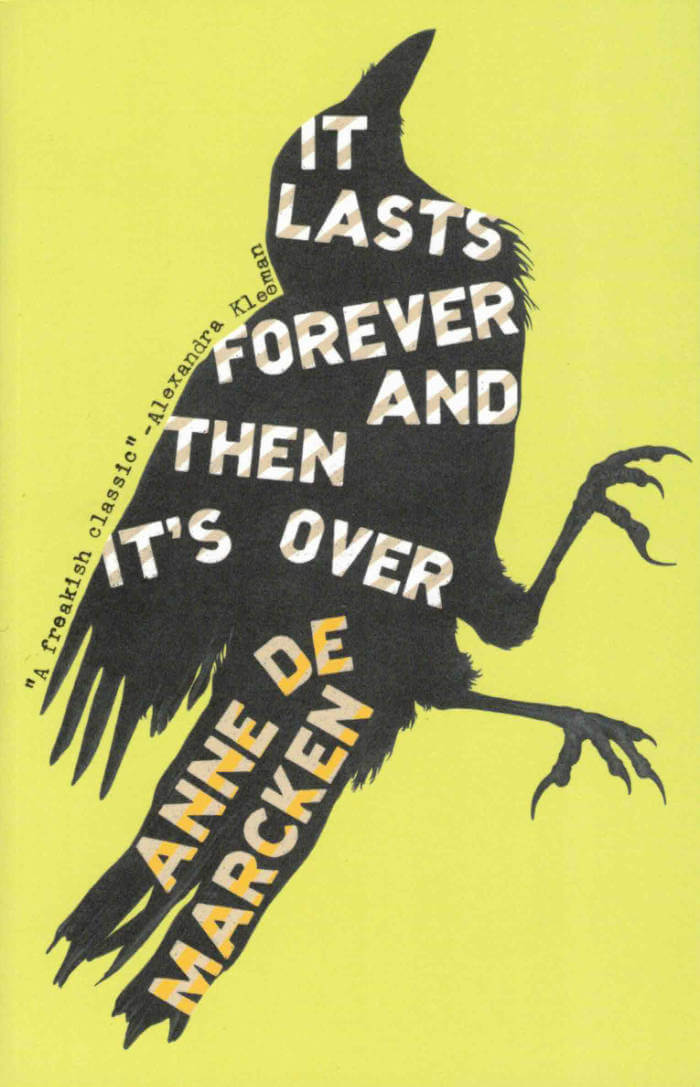
It Lasts Forever and Then It's Over
Co-winner of the 2022 Novel Prize, this incredible life-after-death novel asks us to consider how much of our memory, of our bodies, of the world as we know it ― how much of what we love can we lose before we are lost? And then what happens?
The heroine of the spare and haunting It Lasts Forever and Then It’s Over is voraciously alive in the afterlife. Adrift yet keenly aware, she notes every bizarre detail of her new reality. And even if she has forgotten her name and much of what connects her to her humanity, she remembers with an implacable and nearly unbearable longing the place where she knew herself and was known―where she loved and was loved.
Traveling across the landscapes of time and of space, heading always west, and carrying a dead but laconically opinionated crow in her chest, our undead narrator encounters and loses parts of her body and her self in one terrifying, hilarious, and heartbreaking situation after another. A bracing writer of great nerve and verve, Anne de Marcken bends reality (and the reader’s mind) with throwaway assurance.
It Lasts Forever and Then It’s Over plumbs mortality and how it changes everything, except possibly love. Delivering a near-Beckettian whopping to the reader’s imagination, this is one of the sharpest and funniest novels of recent years, a tale for our dispossessed times.

The Extinction of Irena Rey
From the International Booker Prize-winning translator and Women's Prize finalist, an utterly beguiling novel about eight translators and their search for a world-renowned author who goes missing in a primeval Polish forest.
Eight translators arrive at a house in a primeval Polish forest on the border of Belarus. It belongs to the world-renowned author Irena Rey, and they are there to translate her magnum opus, Gray Eminence. But within days of their arrival, Irena disappears without a trace.
The translators, who hail from eight different countries but share the same reverence for their beloved author, begin to investigate where she may have gone while proceeding with work on her masterpiece. They explore this ancient wooded refuge with its intoxicating slime molds and lichens and study her exotic belongings and layered texts for clues. But doing so reveals secrets-and deceptions-of Irena Rey's that they are utterly unprepared for. Forced to face their differences as they grow increasingly paranoid in this fever dream of isolation and obsession, soon the translators are tangled up in a web of rivalries and desire, threatening not only their work but the fate of their beloved author herself.
This hilarious, thought-provoking debut novel is a brilliant examination of art, celebrity, the natural world, and the power of language. It is an unforgettable, unputdownable adventure with a small but global cast of characters shaken by the shocks of love, destruction, and creation in one of Europe's last great wildernesses.

Things You May Find Hidden in My Ear: Poems from Gaza
Winner of the 2022 Palestine Book Awards Creative Award
Finalist for the National Book Critics Circle Award in Poetry
These poems emerge directly from the experience of growing up and living one’s entire life in Gaza, making a life for one’s family and raising a family in constant lockdown, and often under direct attack.
In this poetry debut, conceived during the Israeli bombing campaign of May 2021, Mosab Abu Toha writes about his life under siege, first as a child, and then as a young father. A survivor of four brutal military attacks, he bears witness to a grinding cycle of destruction and assault, and yet, his poetry is inspired by a profoundly universal humanity.
In direct, vivid language, Abu Toha tells of being wounded by shrapnel at the age of 16 and, a few years later, watching his home and his university get hit by IDF warplanes in a bombing campaign that killed two of his closest friends. These poems are filled with rubble and the ever-present menace of surveillance drones policing a people unwelcome in their own land, and they are also suffused with the smell of tea, roses in bloom, and the view of the sea at sunset. Children are born, families continue traditions, students attend university, and libraries rise from the ruins as Palestinians go on about their lives, creating beauty and finding new ways to survive.

Biography of X (paperback)
From one of our fiercest stylists, a roaring epic chronicling the life, times, and secrets of a notorious artist.
When X—an iconoclastic artist, writer, and polarizing shape-shifter—falls dead in her office, her widow, wild with grief and refusing everyone’s good advice, hurls herself into writing a biography of the woman she deified. Though X was recognized as a crucial creative force of her era, she kept a tight grip on her life story. Not even CM, her wife, knew where X had been born, and in her quest to find out, she opens a Pandora’s box of secrets, betrayals, and destruction. All the while, she immerses herself in the history of the Southern Territory, a fascist theocracy that split from the rest of the country after World War II, as it is finally, in the present day, forced into an uneasy reunification.
A masterfully constructed literary adventure complete with original images assembled by X’s widow, Biography of X follows a grieving wife seeking to understand the woman who enthralled her. CM traces X’s peripatetic trajectory over decades, from Europe to the ruins of America's divided territories, and through her collaborations and feuds with everyone from Bowie and Waits to Sontag and Acker. And when she finally understands the scope of X’s defining artistic project, CM realizes her wife’s deceptions were far crueler than she imagined.
Pulsing with suspense and intellect while blending nonfiction and fiction, Biography of X is a roaring epic that plumbs the depths of grief, art, and love. In her most ambitious novel yet, Catherine Lacey, one of our most acclaimed literary innovators, pushes her craft to its highest level, introducing us to an unforgettable character who, in her tantalizing mystery, shows us the fallibility of the stories we craft for ourselves.